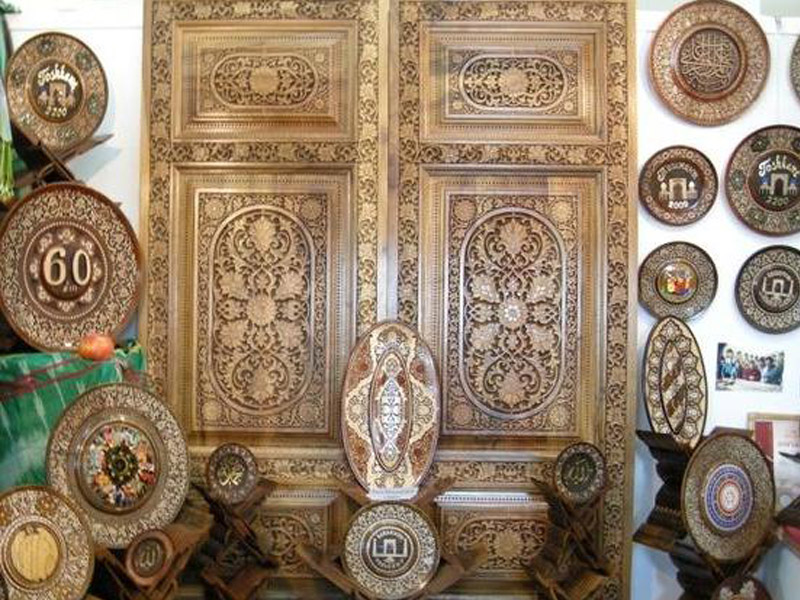



Attraction

Recreation

The pottery of Khorezm reached a new level of development in the Kangyu period. The moulding techniques of the wheel were fully mastered as the basic means of technology and ornamentation. The polished red pots of Toprak-kala exemplify this.
In the Afrigid period (fourth - seventh centuries) Khorezmian ceramics declined. The big handmade vessels of this period were made from rough clay dough with the large amount of admixture. The process of polishing disappeared; the red clear tone changed into greenish-gray and greenish-yellow colors. And the form, the ornamentation, and techniques for making the vessels changed.
When Islam came to Central Asia and international trade developed rapidly, the market for ceramics also grew. In connection with the demand for glazed ceramics, guilds of pottery craftsmen appeared. In the eighth — twelfth centuries ceramic art and technology developed and new types of ceramic vessels appeared; and correspondingly, the style and character of their decoration changed. Ornamental pattern took on a new importance related to marketability. The masters created new varieties of cups, dishes, and jugs. The main achievement of the potters was the improvement in the production of glazed items. They developed double-glazing with a wide variety of including green, lilac, brown, white, yellow, and red. They also used modest forms of engraving. Different compositions were developed in decorating the cups and dishes. Using various ornamental motifs - zoomorphic, cosmogony, geometric, epigraphic — the ceramists worked out their artistic language. The style was one common all types of applied art in the Middle and Hear East, but with characteristics peculiar to Khorezm.
The destructive invasions of the Mongol Horde at the beginning of the thirteenth century disrupted the economy and culture of the Central Asia, including the work of its craftsmen. But owing to the perennial demand for ceramic vessels, the pottery production revived earlier than the other trades. By the fourteenth century the local artistic ceramics arose again. The size of ceramic items became more varied in this period, as did forms and colors. Innovations in the baking and stamping processes made possible the mass production of items with relief ornament. Water pots and cups took on new colors — an elegant gamut of blue and black and green-turquoise colors. The ornamentation included stylized plant elements, spotted patterns, and rosettes in the form of stylized fish and other figures.
Many examples of cups and vases from this period have been recovered from Kunya-Urgench, Mizdakkhana, and Khiva. An ornamental medallion fills their inner surfaces or bird figures against a background detailed ornament. The colors included black-green, cobalt blue and turquoise-blue. In the fourteenth century the ceramics of Khorezm influenced the regions of Volga and the northern Caucasus.
In the fifteenth and sixteenth centuries Khorezm ceramics with blue painting were widespread, in imitation of the China porcelains of the cobalt type, which were imported to Central Asian.
In the sixteenth and seventeenth centuries the ceramics of Khorezm, like other types of applied art, declined, and the skill of forming and painting of vessels dropped. But many traditional features were preserved in the work of masters, such as items with painting on a white background and one-color vessels covered with a turquoise glaze.
The rise of architectural ceramics was a major event in this art form in Khiva in the first half of the nineteenth century.
One of the Russian travelers wrote: «They make very nice large vessels, more durable than ours and they know to glaze them with various colors». The potters made not only large items, but also whole wedding-sets; consisting of several hundred dishes, separate tureens and cups. Traditional forms and sizes developed during this period: koshin-badiya, ulu-badiya, mashadi-badiya, chanoq-badiya. For solemn occasions special vessels: tuy-tavoq or pudshoi were made. The centric, four part radial and combined styles of painting occupied the whole surface of the badiya. The elegance of plant patterns combined harmonically with refined cold color in these items.
At the end of the nineteenth century and at the beginning of the twentieth century, despite the hard conditions of the life and cultural decay, the masters managed to preserve the traditions of their art. In ceramics well-known masters were Allakora, usto Yusup-kulol, usto Veis, Iskandar, and Kalantarov. In general, the coloring of the painting of ceramics is somewhat darker at this period; a new green became prevalent, and white and blue colors were used only for details. New forms of ornamentation appeared, with new themes represented.
The art of Khiva ceramic specialists preserved its peculiarity in the twentieth century as well. In modern ceramics of Khiva, the dark blue-white-sky blue combination of colors predominated. Such masters as R. Matchanov, B.Vaisov, E. Sapaev, A.Yakubov, K. Doschanov and others prefer it. S. Masharipov, E. Razzakov, M. Bekchanov prefer yellow-green and brown tones. Two types of ornament predominate: arabesque and plant-motif.
Artistic ceramics can be divided into three types according to form. The first is items of small size and horizontal configurations — badi-ya, chanoq, deep chanoq, big badiya, deep badiya and taghora. The second type includes items of big size and high forms — big jugs, guppi, digirs (vessels for water mills), big jugs and others. The third consists of items with vertically elongated forms, but of small sizes — vases, ceramic forms for making traditional headwear (chugirma), flowerpots, water vessels, vessels for milk products (chorquloq), etc.
During the twentieth century one can see development in the decorative style of Khorezm ceramic art. By the mid of the twentieth century the large ornament began to dominate.
Motifs varied. The motives: yaproq (leaves), turt-yaproq (four leaves), khushruy gul (beautiful flower), olma (apple flower), combined with patterns: doira (circle), uchburchak (triangle), yarim doira (semi-circle), turtburchak (square). The following zoomophic pictures are widely used: qargha tumshuq (raven's beak), (snake), baliq (fish). The specialists of ceramics use different methods: engraving, brush painting arid carved pattern.
The leading place among the Khorezm ceramists belongs to the potter from the village Madir, R. Matchonov who continues the traditions of the Khiva School, as a skilful orria-mentalist and master-painter of the traditional badiya. The ceramics of this master is marked by its clearness of the style and vivid graphics. R. Matchonov mostly uses cobalt; that is why dark-blue, sky-blue, and darker colors prevail in his work. The lighter-colored work of S. Atajonov from Kattabogh is also well known. The badiyas made by the master E.Sapaev are also highly prized for their ancient motifs.